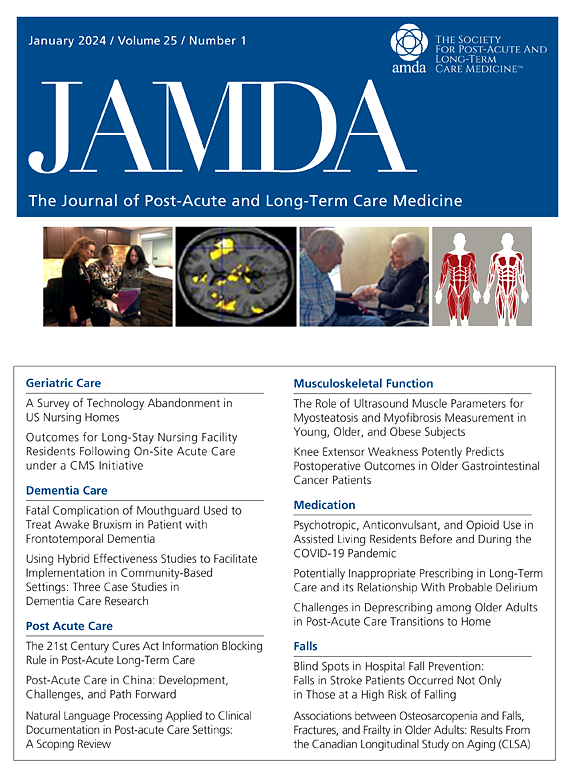简化肌肉减少症筛查:基于社区的筛查和评估组合评估。
IF 3.8
2区 医学
Q2 GERIATRICS & GERONTOLOGY
Journal of the American Medical Directors Association
Pub Date : 2025-06-11
DOI:10.1016/j.jamda.2025.105703
引用次数: 0
摘要
目的:肌肉减少症是老年人的一种严重疾病,其特征是肌肉损失和身体衰退。早期发现至关重要,但由于症状微妙,因此具有挑战性。亚洲肌少症工作组(AWGS) 2019共识建议检测可能的肌少症,但建议的工具的有效性各不相同,理想的筛查组合仍不清楚。本研究旨在确定社区环境中早期肌少症检测最合适的筛查途径。设计:前瞻性横断面研究。环境和参与者:参与者是从2018年10月至2019年11月期间提供聚集餐饮服务的地点招募的。符合条件的参与者是50岁或以上的社区居民,他们有能力完成完整的肌肉减少症调查。方法:采用AWGS 2019算法推荐的所有评估方法。我们将这些测试分为12个不同的途径,每个途径都结合了病例发现方法和评估,要么是肌肉力量测试,要么是身体表现测试。骨骼肌质量测量采用生物电阻抗分析法。然后比较不同组合的效度。结果:本研究共纳入567名受试者。在3种病例发现工具中,小腿围度灵敏度最高,而SARC-F(力量、行走辅助、从椅子上站起来、爬楼梯和跌倒)灵敏度最低(80%对8%)。在测试的12种不同的筛选组合中,涉及小腿围的途径优于涉及SARC-F或SARC-F与小腿围(SARC-CalF)的途径。值得注意的是,小腿围和手握力的组合成为最佳途径,具有最佳的灵敏度和令人满意的特异性,以及优越的区分能力(由受术者工作特征分析表明)和预测准确性(由Brier评分表明)。结论和意义:在社区环境中,结合小腿围和手握力是检测肌肉减少症最有效的筛查途径。它的性能甚至接近于完成AWGS 2019共识中概述的所有测试。这种简化的途径可以作为一种实用的筛查选择在社区设置。本文章由计算机程序翻译,如有差异,请以英文原文为准。
Simplifying Sarcopenia Screening: A Community-Based Evaluation of Screening and Assessment Combinations
Objectives
Sarcopenia is a serious condition in older individuals, characterized by muscle loss and physical decline. Early detection is crucial but challenging due to subtle symptoms. The Asian Working Group for Sarcopenia (AWGS) 2019 consensus recommends detection for possible sarcopenia, but the effectiveness of the suggested tools varies, and the ideal screening combination remains unclear. This study aims to identify the most suitable screening pathway for early sarcopenia detection in community settings.
Design
Prospective cross-sectional study.
Setting and Participants
Participants were recruited from locations offering congregated meal services between October 2018 and November 2019. Eligible participants were community-dwelling residents aged 50 years or older who were capable of completing the full sarcopenia survey.
Methods
All assessments recommended in the AWGS 2019 algorithm were conducted. We organized these tests into 12 distinct pathways, each combining a case-finding method with an assessment, either a muscle strength test or a physical performance test. Skeletal muscle mass was measured using bioelectrical impedance analysis. The validity of different combinations was then compared.
Results
A total of 567 participants were enrolled in this study. Among the 3 case-finding tools, calf circumference had the highest sensitivity and the SARC-F (strength, assistance with walking, rising from a chair, climbing stairs, and falls) had the lowest (80% vs 8%). Across the 12 different screening combinations tested, pathways involving calf circumference outperformed those involving the SARC-F or the SARC-F combined with calf circumference (SARC-CalF). Notably, the combination of calf circumference and handgrip strength emerged as the optimal pathway, offering the best sensitivity and satisfactory specificity, along with superior discrimination ability (indicated by receiver operating characteristic analysis) and prediction accuracy (indicated by Brier score).
Conclusions and Implications
The combination of calf circumference and handgrip strength is the most effective screening pathway for detecting sarcopenia in community settings. Its performance is even close to conducting all the tests outlined in the AWGS 2019 consensus. This simplified pathway may serve as a practical screening option in community settings.
求助全文
通过发布文献求助,成功后即可免费获取论文全文。
去求助
来源期刊
CiteScore
11.10
自引率
6.60%
发文量
472
审稿时长
44 days
期刊介绍:
JAMDA, the official journal of AMDA - The Society for Post-Acute and Long-Term Care Medicine, is a leading peer-reviewed publication that offers practical information and research geared towards healthcare professionals in the post-acute and long-term care fields. It is also a valuable resource for policy-makers, organizational leaders, educators, and advocates.
The journal provides essential information for various healthcare professionals such as medical directors, attending physicians, nurses, consultant pharmacists, geriatric psychiatrists, nurse practitioners, physician assistants, physical and occupational therapists, social workers, and others involved in providing, overseeing, and promoting quality

 求助内容:
求助内容: 应助结果提醒方式:
应助结果提醒方式:


